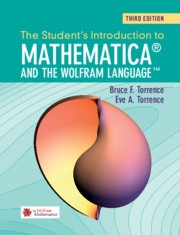Refine search
Actions for selected content:
48274 results in Computer Science
REC volume 31 issue 2 Cover and Back matter
-
- Article
-
- You have access
- Export citation

The Student's Introduction to Mathematica and the Wolfram Language
-
- Published online:
- 01 April 2019
- Print publication:
- 16 May 2019
Controlling Perception Thresholds for Changing Timbres in Continuous Sounds
-
- Journal:
- Organised Sound / Volume 24 / Issue 1 / April 2019
- Published online by Cambridge University Press:
- 30 May 2019, pp. 71-84
- Print publication:
- April 2019
-
- Article
- Export citation
NLE volume 25 issue 2 Cover and Front matter
-
- Journal:
- Natural Language Engineering / Volume 25 / Issue 2 / March 2019
- Published online by Cambridge University Press:
- 01 April 2019, pp. f1-f2
-
- Article
-
- You have access
- Export citation
Of Pipes and Patches: Listening to augmented pipe organs
-
- Journal:
- Organised Sound / Volume 24 / Issue 1 / April 2019
- Published online by Cambridge University Press:
- 30 May 2019, pp. 41-53
- Print publication:
- April 2019
-
- Article
- Export citation
The Study of Acousmatic Listening Behaviours
-
- Journal:
- Organised Sound / Volume 24 / Issue 1 / April 2019
- Published online by Cambridge University Press:
- 30 May 2019, pp. 8-19
- Print publication:
- April 2019
-
- Article
- Export citation
GANs vs. good enough
-
- Journal:
- Natural Language Engineering / Volume 25 / Issue 2 / March 2019
- Published online by Cambridge University Press:
- 01 April 2019, pp. 323-329
-
- Article
-
- You have access
- Open access
- HTML
- Export citation
OSO volume 24 issue 1 Cover and Front matter
-
- Journal:
- Organised Sound / Volume 24 / Issue 1 / April 2019
- Published online by Cambridge University Press:
- 30 May 2019, pp. f1-f2
- Print publication:
- April 2019
-
- Article
-
- You have access
- Export citation
‘Primacy of the Ear’ – But Whose Ear?: The case for auraldiversity in sonic arts practice and discourse
-
- Journal:
- Organised Sound / Volume 24 / Issue 1 / April 2019
- Published online by Cambridge University Press:
- 30 May 2019, pp. 85-95
- Print publication:
- April 2019
-
- Article
- Export citation
Hearing How It Feels to Listen: Perception, embodiment and first-person field recording
-
- Journal:
- Organised Sound / Volume 24 / Issue 1 / April 2019
- Published online by Cambridge University Press:
- 30 May 2019, pp. 30-40
- Print publication:
- April 2019
-
- Article
- Export citation
Recovering Music-Theatre Works Involving Electronic Elements: The case of Molly Bloom and FE…DE…RI…CO…
-
- Journal:
- Organised Sound / Volume 24 / Issue 1 / April 2019
- Published online by Cambridge University Press:
- 30 May 2019, pp. 96-108
- Print publication:
- April 2019
-
- Article
- Export citation
OSO volume 24 issue 1 Cover and Back matter
-
- Journal:
- Organised Sound / Volume 24 / Issue 1 / April 2019
- Published online by Cambridge University Press:
- 30 May 2019, pp. b1-b2
- Print publication:
- April 2019
-
- Article
-
- You have access
- Export citation
Sound Objects and Spatial Morphologies
-
- Journal:
- Organised Sound / Volume 24 / Issue 1 / April 2019
- Published online by Cambridge University Press:
- 30 May 2019, pp. 20-29
- Print publication:
- April 2019
-
- Article
- Export citation
Editorial: Perceptual issues surrounding the electroacoustic listening experience
-
- Journal:
- Organised Sound / Volume 24 / Issue 1 / April 2019
- Published online by Cambridge University Press:
- 30 May 2019, pp. 1-7
- Print publication:
- April 2019
-
- Article
-
- You have access
- HTML
- Export citation
Samantha Bennett and Eliot Bates (eds.), Critical Approaches to the Production of Music and Sound. London/New York: Bloomsbury, 2018. ISBN: 978-1-501-33205-0 (hardback).
-
- Journal:
- Organised Sound / Volume 24 / Issue 1 / April 2019
- Published online by Cambridge University Press:
- 30 May 2019, pp. 111-112
- Print publication:
- April 2019
-
- Article
- Export citation
Effectiveness of data-driven induction of semantic spaces and traditional classifiers for sarcasm detection
-
- Journal:
- Natural Language Engineering / Volume 25 / Issue 2 / March 2019
- Published online by Cambridge University Press:
- 01 April 2019, pp. 257-285
-
- Article
- Export citation
